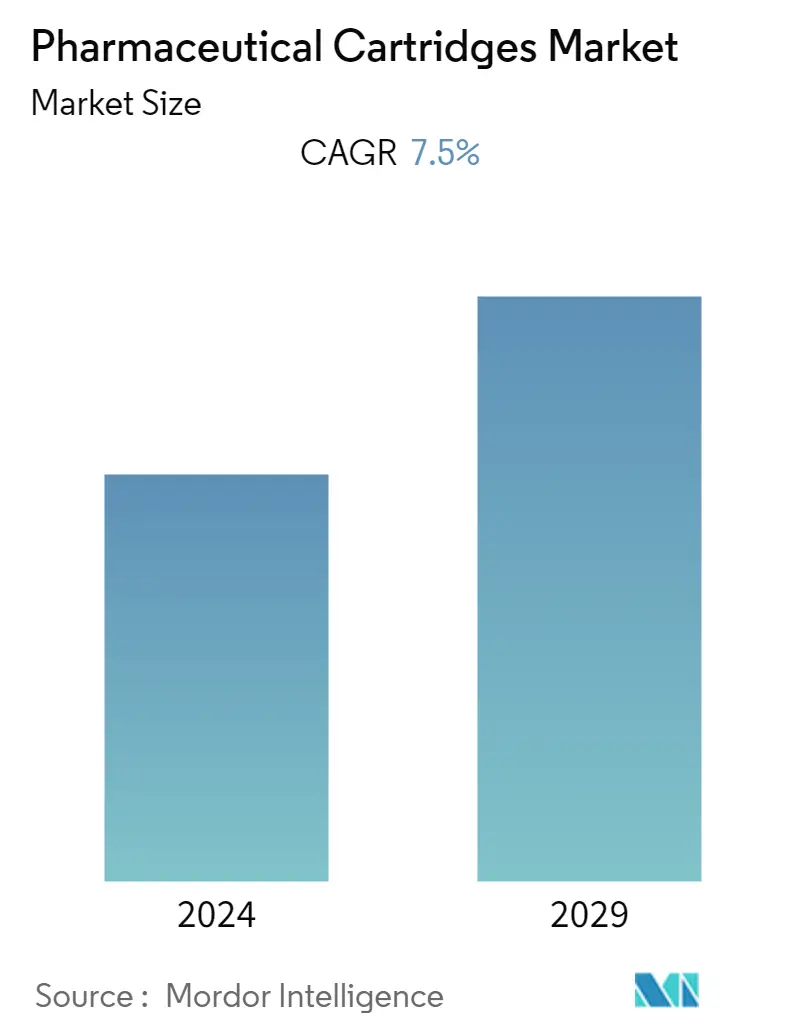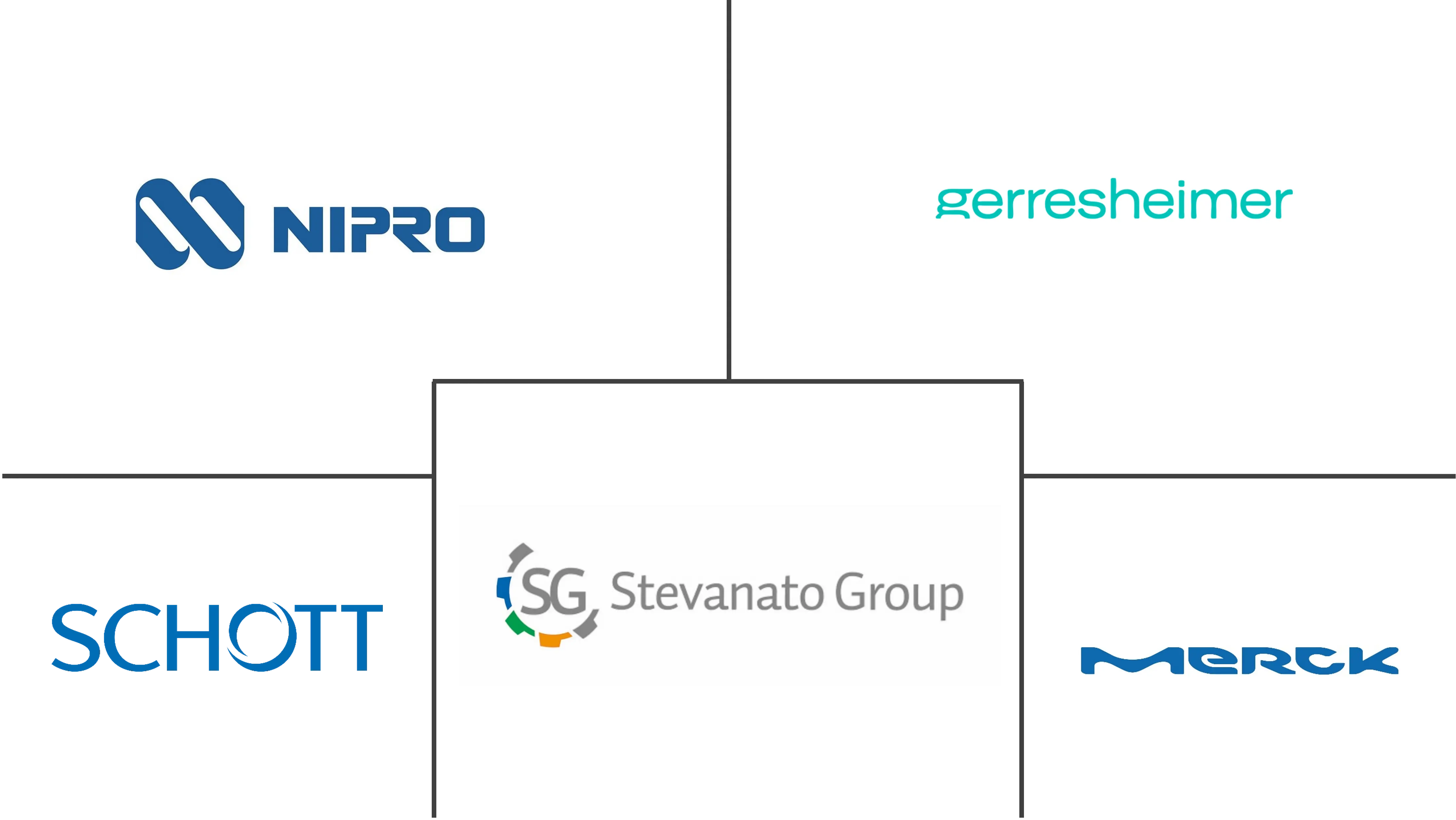Market Size of Pharmaceutical Cartridges Industry

| Study Period | 2024 - 2029 |
| Base Year For Estimation | 2023 |
| CAGR | 7.50 % |
| Fastest Growing Market | Asia Pacific |
| Largest Market | North America |
| Market Concentration | Medium |
Major Players
*Disclaimer: Major Players sorted in no particular order |
Pharmaceutical Cartridges Market Analysis
The Pharmaceutical Cartridges Market is expected to grow at a significant CAGR of 7.5% during the forecast period.
The COVID-19 pandemic has disrupted the pharmaceutical cartridges market in the initial phase due to the disruptions in the production and distribution of pharmaceutical cartridges. However, the pandemic has also led to a surge in demand for a wide range of drugs, vaccines, and other essential pharmaceuticals which created a huge demand for pharmaceutical cartridges. For instance, a total of 11.4 billion doses of COVID-19 vaccines have been administered globally as of April 2022. Countries with vaccine manufacturing capabilities such as the United States, China, India, Germany, and the United Kingdom have administered more than 100 vaccine doses per 100 people. Also, around 16 billion vaccine doses worth USD 141 billion were supplied in 2021 which is nearly 3.5 times of 2019. Thus, the huge demand for vaccines positively impacted the pharmaceutical cartridges market.
The key factors driving the growth of the pharmaceutical cartridges market are the increase in research & development (R&D) spending in the pharmaceutical industry, technological advancements in drug delivery devices, and the growing prevalence of chronic diseases. For instance, in 2022, according to SHL Medical an innovative method known as Needle Isolation Technology (NIT) is developed to address the problems with cartridge-based injection devices. Based on a pre-installed needle hidden inside the device, the technology eliminates the need for users to manually attach the needle. With NIT, users merely remove the cap to insert the needle prior to injection, allowing the fluid route to be opened and the injector to automatically prime. Such advancements in products will contribute to the growth of the pharmaceutical cartridge market.
However, the development of new drugs creates demand for pharmaceutical cartridges products. For instance, according to a report by the International Federation of Pharmaceutical Manufacturers and Associations, globally, 64 novel active substances (NAS) have been launched in 2022, while more than 6,147 products are currently in active development from Phase 1 to regulatory submission. There are currently more than 9,000 drugs in development across all therapeutic areas, along with 260 vaccines. Such developments of novel drugs are likely to create demand for pharmaceutical cartridges over the forecast period.
However, the challenges associated with material such as damage or breakage during transportation may hinder the growth of the pharmaceutical cartridges market.
Pharmaceutical Cartridges Industry Segmentation
As per the scope of the report, pharmaceutical cartridges are glass containers of cylindrical shape, suitable for liquid, or solid pharmaceutical dosage forms. The Pharmaceutical Cartridges Market is Segmented by Material (Glass (Type 1, Type 2, Type 3, Type 4), Plastic (Polyethylene Terephthalate (PET), High-Density Polyethylene (HDPE), Other Plastic Material), Rubber), Capacity (Less than 3ml, 3ml-5ml, 5ml-10ml, more than 10 ml), Therapeutic Area (Ophthalmology, Respiratory, Neurology, Oncology, Immunology, Cardiology, Diabetes, Dental, Other Therapeutic Area), End User (Pharmaceutical Companies, Biotech Companies, Other End User), and Geography (North America, Europe, Asia-Pacific, Middle East and Africa). The market report also covers the estimated market sizes and trends for 17 countries across major regions globally. The report offers a value of USD billion for the above segments.
| By Material | ||||||
| ||||||
| ||||||
| Rubber |
| By Capacity | |
| Less than 3ml | |
| 3ml-5ml | |
| 5ml-10ml | |
| More than 10 ml |
| By Therapeutic Area | |
| Ophthalmology | |
| Respiratory | |
| Neurology | |
| Oncology | |
| Immunology | |
| Cardiology | |
| Diabetes | |
| Dental | |
| Other Therapeutic Area |
| By End User | |
| Pharmaceutical Companies | |
| Biotechnology Companies | |
| Other End Users |
| Geography | ||||||||
| ||||||||
| ||||||||
| ||||||||
| ||||||||
|
Pharmaceutical Cartridges Market Size Summary
The pharmaceutical cartridges market is poised for substantial growth, driven by increased research and development spending, technological advancements in drug delivery devices, and the rising prevalence of chronic diseases. The COVID-19 pandemic initially disrupted the market but ultimately spurred demand for pharmaceutical cartridges due to the surge in vaccine production and distribution. Innovations such as Needle Isolation Technology have further propelled the market by enhancing the functionality of cartridge-based injection devices. The development of novel drugs and vaccines continues to create a robust demand for pharmaceutical cartridges, although challenges related to material damage during transportation persist. The glass material segment is expected to experience significant growth, attributed to its superior quality, chemical resistance, and compatibility with various drug delivery systems, making it a preferred choice for preserving and administering sensitive pharmaceuticals.
North America is anticipated to lead the pharmaceutical cartridges market, supported by a well-developed healthcare infrastructure and stringent regulatory oversight. The region's growth is fueled by the high demand for drugs and precise delivery systems, driven by the prevalence of chronic diseases and an aging population. Increased investment in research and development by major pharmaceutical companies in the United States and Canada further bolsters market expansion. Key players in the market, such as Schott AG, Nipro Corporation, and Stevanato Group, are actively engaging in strategies like product launches and regional expansions to strengthen their market presence. The competitive landscape remains moderately intense, with companies continuously innovating to meet the evolving demands of the pharmaceutical industry.
Pharmaceutical Cartridges Market Size - Table of Contents
-
1. MARKET DYNAMICS
-
1.1 Market Overview
-
1.2 Market Drivers
-
1.2.1 Rising Demand for Easy to Use and Convenient Pharmaceutical Packaging Solutions
-
1.2.2 Increase in R&D Spending in the Pharmaceutical Industry
-
-
1.3 Market Restraints
-
1.3.1 Manufacturing Complexity and Stringent Regulatory Compliance Related to Pharmaceutical Cartridges
-
-
1.4 Porter's Five Force Analysis
-
1.4.1 Threat of New Entrants
-
1.4.2 Bargaining Power of Buyers/Consumers
-
1.4.3 Bargaining Power of Suppliers
-
1.4.4 Threat of Substitute Products
-
1.4.5 Intensity of Competitive Rivalry
-
-
-
2. MARKET SEGMENTATION (Market Size by Value - USD million)
-
2.1 By Material
-
2.1.1 Glass
-
2.1.1.1 Type 1
-
2.1.1.2 Type 2
-
2.1.1.3 Type 3
-
2.1.1.4 Type 4
-
-
2.1.2 Plastic
-
2.1.2.1 Polyethylene Terephthalate (PET)
-
2.1.2.2 High-Density Polyethylene (HDPE)
-
2.1.2.3 Other Plastic Material
-
-
2.1.3 Rubber
-
-
2.2 By Capacity
-
2.2.1 Less than 3ml
-
2.2.2 3ml-5ml
-
2.2.3 5ml-10ml
-
2.2.4 More than 10 ml
-
-
2.3 By Therapeutic Area
-
2.3.1 Ophthalmology
-
2.3.2 Respiratory
-
2.3.3 Neurology
-
2.3.4 Oncology
-
2.3.5 Immunology
-
2.3.6 Cardiology
-
2.3.7 Diabetes
-
2.3.8 Dental
-
2.3.9 Other Therapeutic Area
-
-
2.4 By End User
-
2.4.1 Pharmaceutical Companies
-
2.4.2 Biotechnology Companies
-
2.4.3 Other End Users
-
-
2.5 Geography
-
2.5.1 North America
-
2.5.1.1 United States
-
2.5.1.2 Canada
-
2.5.1.3 Mexico
-
-
2.5.2 Europe
-
2.5.2.1 Germany
-
2.5.2.2 United Kingdom
-
2.5.2.3 France
-
2.5.2.4 Italy
-
2.5.2.5 Spain
-
2.5.2.6 Rest of Europe
-
-
2.5.3 Asia-Pacific
-
2.5.3.1 China
-
2.5.3.2 Japan
-
2.5.3.3 India
-
2.5.3.4 Australia
-
2.5.3.5 South Korea
-
2.5.3.6 Rest of Asia-Pacific
-
-
2.5.4 Middle East and Africa
-
2.5.4.1 GCC
-
2.5.4.2 South Africa
-
2.5.4.3 Rest of Middle East and Africa
-
-
2.5.5 South America
-
2.5.5.1 Brazil
-
2.5.5.2 Argentina
-
2.5.5.3 Rest of South America
-
-
-
Pharmaceutical Cartridges Market Size FAQs
What is the current Pharmaceutical Cartridges Market size?
The Pharmaceutical Cartridges Market is projected to register a CAGR of 7.5% during the forecast period (2024-2029)
Who are the key players in Pharmaceutical Cartridges Market?
Nipro Corporation, Gerresheimer AG, Merck KGaA, Stevanato Group and Schott AG are the major companies operating in the Pharmaceutical Cartridges Market.

